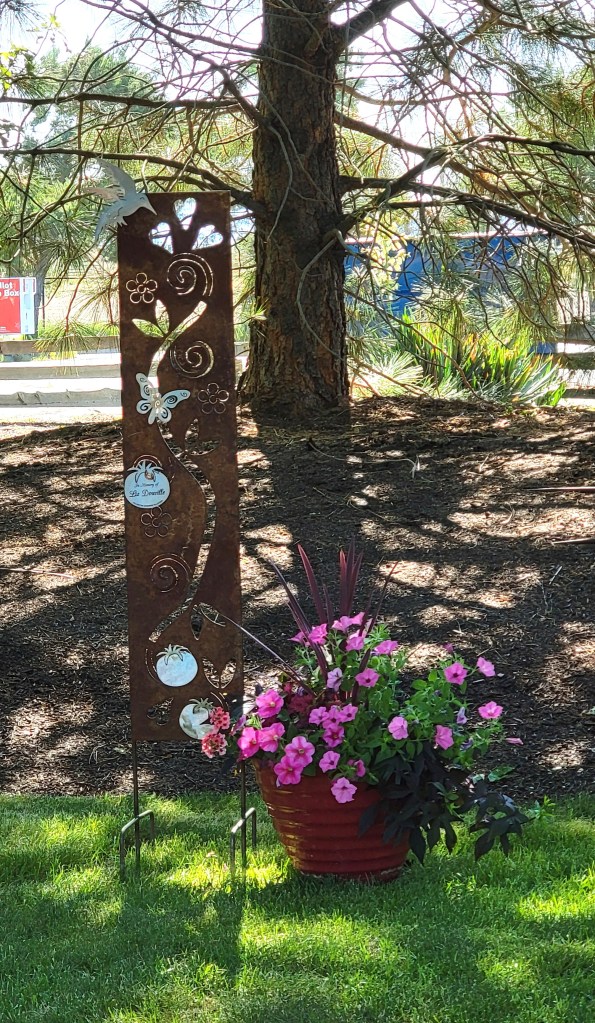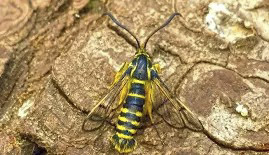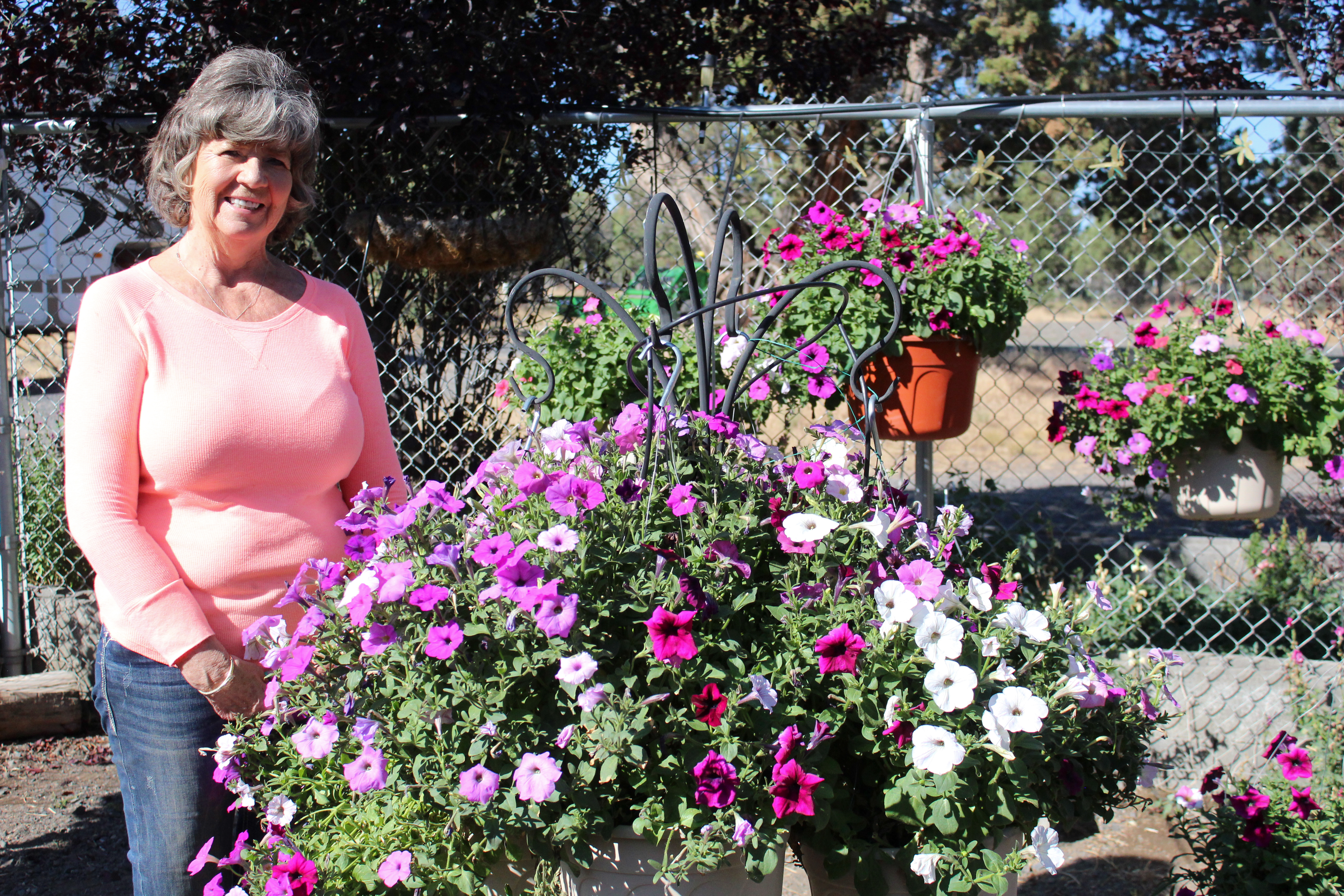Summer gardening tips and calendar
Published 5:00 am Friday, July 11, 2025

- A Liz Douville totem (Submitted by Marilyn Clark)
If you are a seasoned gardener, many of these tips will be well known. But even experienced gardeners may be surprised by a few topics – what not to do in the heat.
I’ll start with the basics of what not to do:
Do not prune conifers between February and September, unless you wish to risk inviting the sequoia pitch moth, which is active and on the wing from May to early September. Fresh pruning wounds will attract egg-laying females. These moths are found throughout Oregon and look like a bee or yellow jacket. Although called a sequoia moth, they also attack pine trees by burrowing into the softwood. They cause tree stress, unsightly resin masses, some limb dieback and even tree death in severe cases. For treatment see: extension.usu.edu/planthealth/research/sequoia-pitch-moth.

A sequoia pitch moth (Submitted by Marilyn Clark)
Trending
Do not spray plants with herbicides such as glyphosate when the temperature is 70 degrees or higher. The chemicals can become more volatile at high temperatures, which increases the risk of drift onto desirable plants.
Do not apply insecticidal soap in direct sunlight – it can cause leaf burn. Heat also causes it to evaporate quickly, reducing its effectiveness. It’s best applied early morning or late evening.
Do not fertilize when the plants are dry or drought stressed. Especially for lawns – it is best to fertilize in spring or fall.
Avoid plant stress. Do not transplant or prune plants during extreme heat.
Do:
Water deeply. Water every five to seven days and aim for water to reach at least 6 inches into the soil. Plants will let you know when they need water — they wilt. Watch for signs of drooping. You can also check soil moisture by digging 2 inches down near the base of the plant. Sandy soil dries out more quickly and may require more frequent watering. Remove weeds, which aggressively compete for water. Container plants need extra watering because they are more exposed and dry out quickly.
Apply mulch. Mulching around plants helps reduce evaporation. Use materials such as straw, compost, decomposed manure or even a couple inches of crushed rock. Organic mulches help improve water retention and overall plant health.
Provide shade. Shade cloth can protect sensitive plants. Use a frame to hold the cloth above the plants, allowing for airflow. Temperatures under shade cloth can be up to 10 degrees cooler. Shade cloth can also be used over cold frames, cloches or greenhouses. I can attest to this. I have an indoor/outdoor thermometer attached to my greenhouse, and it regularly registers 10 degrees lower inside after the shade cloth goes on. During extreme heat domes, some gardeners even staked umbrellas over selected heat-stressed plants.
Deadheading flowers are OK th
roughout the summer. This is the process of pruning or hand pinching to remove seed heads which redirects the plants energy to produce more blooms rather than seeds. It is also beneficial if you wish to prevent the spread of prolific seed producers, such as red-hot poker plants and coreopsis.
Tips for future success:
Mow smarter. Most lawns in Central Oregon are cool season mixes and include Kentucky bluegrass, fescue and perennial ryes. The mowing height should be set to 2-½ to 3-½ inches rather than 2 inches. Taller grass shades the ground from the sun and helps retain moisture in the soil.
Go native. Native plants are those which have evolved in a region over thousands of years, adapting to the changing environment. Central Oregon is the high desert. There are plants that more easily adapt to our heat waves once established in your garden.
Smart irrigation. Use efficient irrigation systems, directing the water where it is needed. Drip systems and soaker hoses deliver water directly to plant roots and reduce evaporation. Timers can be adjusted to provide more water during hotter months, both frequency and length of watering period. Pay attention to the most recently planted flowers, shrubs and trees and provide sufficient water until they have established their root systems – sometimes 2–3 years.
Group plants for water needs. You can look up the water needs of your plants, either from the purchase information tags or from OSU Extension website publications. My trees are on a separate watering system than my perennials because they require less frequent but longer-deeper watering cycles.
What’s happening:
The Central Oregon Master Gardener Association (www:gocomga.com) calendar of events brings a number of opportunities to view and discuss gardening issues as follows:
July 19, 2026, 8:30 a.m. to 3:30 p.m.
High Desert Garden Tour by the OSU Extension
Self-guided tour of six gardens in the Bend area.0
The cost is $15 per ticket.
July 26, 2025, 10 a.m. to 12 p.m.
Saturdays in the Garden: Alpenglow Demo Garden
“Right Plant, Right Place”
Microclimates! Deer! Rodents! Sun! Wind! Snow! Where to plant? When to plant? What is hardening off? Learn how to select the right plants for your garden and make them thrive.
Registration: eventbrite.com/e/right-plant-right-place-tickets-1323266488689
August 9, 2025, 9 a.m. to 12 p.m.
Hollinshead Open Gardens
Hollinshead Park, 1235 NE Jones Road, Bend
Visit the Master Gardener managed community and water-wise gardens and see all that can be grown in Central Oregon.
August 23, 2025, 10 a.m. to 12 p.m.
Saturdays in the Garden: Redmond Demo Garden
3800 SW Airport Way, Building 3, Redmond (next to the Deschutes County Fairgrounds)
“Let’s Keep the Garden Growing!”
Demos on:
– Dead Heading to promote more blooms,
– Weed ID and Control,
– First Harvest of All American Selection
Registration: eventbrite.com/e/lets-keep-this-garden-growing-tickets-1323272125549
If you’ve never been to the Redmond demo garden, you will be surprised at what grows there. And if it grows there, it can grow in surrounding communities. Numerous perennials, berries, shrubs, trees and fruit trees are thriving. One section is also dedicated to vegetables and annual flower trials. Best yet, the plants are labeled! Find something you like and snap a photo. You will be surprised how beautiful some of the native plants are. You can even look for the garden art memorial totem dedicated to long-term Master Gardener volunteer and former garden columnist for the Bulletin – Liz Douville.
Enjoy your garden tours!







